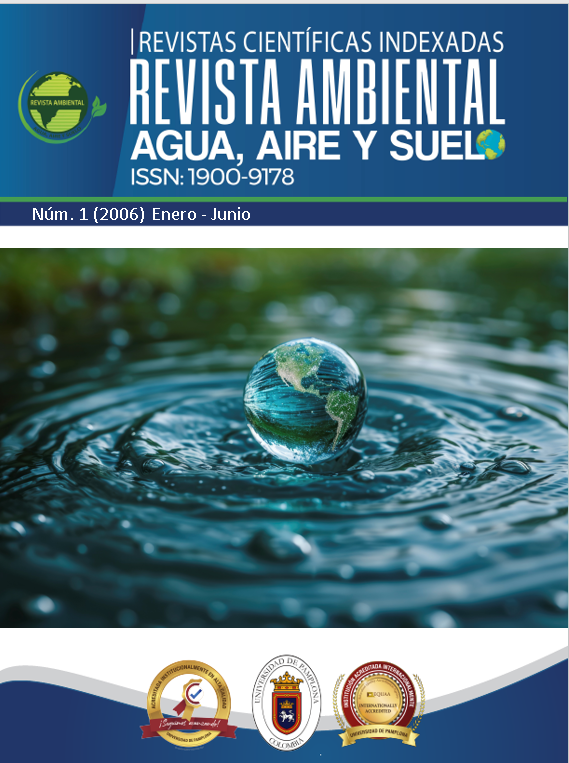Design of a series of bucket biodigesters to obtain methane gas and fertilizers from the fermentation of pig manure.
DOI:
https://doi.org/10.24054/aaas.vi1.2044Keywords:
Biodigester, design, biomass, biogas, biofertilizer, biofertilizers, excrement, pig manureAbstract
A six-tank biodigester was designed and built, with each tank measuring 55 gallons, 0.6 m in diameter, and an average height of approximately 0.9 m. The design of the biodigester was influenced by factors such as the desired energy output, the available biomass, the volume of the biodigester, and the average temperature of the location, using pig manure as biomass for a continuous feed system. The volume of each barrel was 208,197 L, for a total biodigester volume of 1,249,182 L (1.3 m³). The average temperature of the site was 30 °C. The longitudinal walls of the pit
had a 10% slope. The slope along the floor was 0.05%. The biodigester was equipped with a biogas collection pipe system, as well as an inlet and outlet box. A network of interconnected pipes was laid at the bottom of the six bins for the distribution of the stabilized biomass. To determine the efficiency of the process in the biodigester, experimental results of physicochemical parameters such as solids, chemical oxygen demand (COD), and methanogenic activity (MA) analysis were evaluated in the laboratory.
Downloads
References
APHA (1995). Standard Methods for the Examination of Water and Wastewater. 19th edition. American Public Health Association, Washington, D.C:
Botero, B.M. y R.P. Thomas. 1987. Biodigestor de bajo costo para la producción de combustible y fertilizante a partir de excretas. Manual para su instalación, operación y utilización. Centro Internacional de Agricultura Tropical. Cali, Colombia.
Bruce, A. Kouzeli-Katsiri y P.J. Newman. Anaerobic digestion of sewage sludge and organic agricultural wastes. Elsevier. New York.
CEMAT. Centro Mesoamericano de Estudios sobre Tecnología Aplicada. 1977. Planta de biogas a pequeña escala de la India. Handbook of Appropriate Technology of the Canadian Munger Fundation. Guatemala, Guatemala.
EL BIOGAS Y SUS APLICACIONES. Pág. 11 - 18.
Feigin, A., I. Ravina y J. Shalnevet. 1991. Irrigation with treated sewage effluent. Management for environmental protection. Adv. Ser. Agric. Sci. 17: 60-68. Springer-Verlag. Berlin, Germany.
Kennedy, J.K. y D.V. Berg. 1982. Anaerobic digestion of piggery waste using a stationary fixed film reactor. Agric. Wastes 4: 151-158.
Mandujano M., I. 1981. Biogás: Energía y fertilizantes a partir de desechos orgánicos.
Manual para el promotor de la tecnología. Organización Latinoamericana de Energía. Cuernavaca, Morelos, México.
Marty, B. 1984. Microbiology of anaerobic digestion. pp. 72-85. In: A.M.
McCaskey, A.T. 1990. Microbiological and chemical pollution potential of swine waste. pp. 12-32. In: Memorias del Primer Ciclo Internacional de Conferencias sobre Manejo y Aprovechamiento de Estiércol de Cerdos. CINVESTAV.
Noyola A. y Monroy O. 1994. Experiencias y expectativas del tratamiento de residuales porcinos en México. Universidad Autónoma Metropolitana. Iztapalapa. pp. 331-340. In: III Taller y Seminario Latinoamericano "Tratamiento Anaerobio de Aguas Residuales". Montevideo, Uruguay.
Prasad C. R.,Krishna Prasad K, Reddy A., Biogás plants: prospects, problems and tasks. Economic and Political Weekly Special number august 1974, pp 1347-1364.
Salazar G., G. 1993. Los digestores: Una alternativa energética en la porcicultura y un medio para evitar la contaminación. SARH-INIFAP-CIPAC. Campo Experimental Centro de Jalisco. Guadalajara, Jalisco, México.
Soria F., M., J. Tun S., A. Trejo R. y R. Terán S. 1994. Producción de hortalizas en la península de Yucatán.
Soubes, M. 1994. Biotecnología de la digestión anaerobia. pp. 136-148. In: III Taller y Seminario Latinoamericano "Tratamiento de Aguas Residuales". Montevideo, Uruguay.
Tchobanoglous, G. y E.D. Schoeder. 1985. W ater quality: Characteristics, modeling, modification. Addison-Wesley. Reading, MA.
Vázquez B., E. y A. Manjarrez R. 1993. Contaminación del agua subterránea por la actividad porcícola. Tecnología del Agua (España) 109: 38-43.
Verastegui L., J. 1980. El biogas como alternativa energética para zonas rurales. OLADE (Organización Latinoamericana de Alternativas de Energía). Boletín Energético del Ecuador 14: 57-94.
Viñas, M. 1994. Criterios de diseño y escalado de reactores anaerobios. pp. 111-123. In: III
Taller y Seminario Latinoamericano "Tratamiento Anaerobio de Aguas Residuales". Montevideo, Uruguay
Torres, D. María. Un Biodigestor de Boñiga de Cabra Calefaccionado con Colectores Planos
Downloads
Published
Issue
Section
License
Copyright (c) 2022 REVISTA AMBIENTAL AGUA, AIRE Y SUELO

This work is licensed under a Creative Commons Attribution-NonCommercial 4.0 International License.










